This page covers:
Here are guidelines on how to handle common oral discomforts and injuries, and when these require emergency dental care or services:
- Professional Cleaning
- Scaling and Root Planing
- Periodontal Surgery
- Broken Jaw: Apply ice or a cold compress to the face. Go to your dentist or an emergency center immediately.
- Keeping your teeth and gums healthy after treatment
Professional Cleaning
In the very early stages – when it is gingivitis – you may just need a professional cleaning from your dental team. They can also give you some great advice and tips on how you can keep your teeth and gums healthy.
Scaling and Root Planing
If your gum disease is beyond gingivitis, the first step in treating gum disease usually involves scaling (SCAY-ling) and root planing (PLAY-ning). This treatment may be done over more than one visit, depending on your personal needs.
Scaling: Your dentist or hygienist removes plaque and tartar down to the bottom of each periodontal pocket.
Root Planing: Then, the root surfaces of your teeth are smoothed, or “planed”, to allow the gum tissue to heal and reattach to the teeth.
Your dentist or hygienist may recommend certain medicines to help control infection and discomfort or to aid healing. You may be given pills, a mouthrinse or they may place medication directly into the periodontal pocket after the treatment.
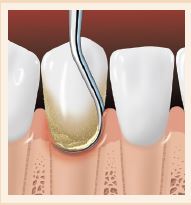
Scaling removes plaque and tartar from below the gum line.
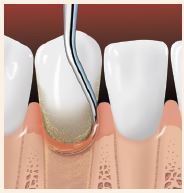
Root planing smoothes the tooth root and helps the gums reattach to the tooth.
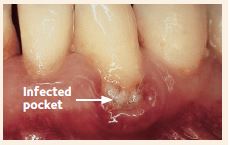
Healed pocket after treatment.
Periodontal Surgery
Sometimes, scaling and root planing isn’t enough treatment on its own. If pockets do not heal enough after scaling and root planing, gum surgery may be needed.
Surgery allows your dentist to remove plaque and tartar from hard-to-reach areas. Afterwards, your gums will be stitched into place to tightly hug your teeth.
Surgery can also help to shrink pocket depth and make it easier for you to keep your teeth clean.
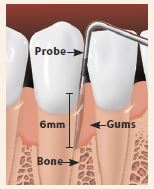
Probe shows pockets due to gum disease. Gums are inflamed and bone loss has occured.
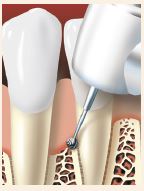
The bone is contoured and any remaining tartar is removed.
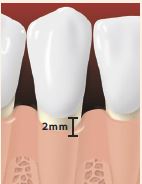
Healed site after periodontal surgery.
Keeping your teeth and gums healthy after treatment
Periodic periodontal cleanings help you stay on top of your gum disease
Once your gum disease is under control, it is very important for you to get dental care on a consistent basis. The periodic cleanings recommended after these treatments are called periodontal maintenance care. These cleanings are more extensive than the standard cleaning and will help you keep your gums healthy. Your periodontal maintenance involves cleanings that are deeper than a normal cleaning in the dental office. With periodic maintenance, the amount of plaque bacteria is lowered. Then, the inflammation can get better, pockets can shrink and your gums can become healthier.
Your gum disease won’t go away on its own
Once your gum disease is brought under control, it is very important that you get dental care on a periodic basis. You have a better chance of keeping your teeth if you do. Your gum disease may get worse if you don’t!
Plan for more visits to the dentist
You will need to see your dentist more often than other people. The pockets and other issues from your gum disease will make it harder for you to clean plaque from your teeth.
Your dentist will talk to you about a treatment plan that works best for you, and he or she will recommend a maintenance care schedule that is based on your personal case. Over time, fewer appointments may be necessary. Once your gums are healthy, your dentist will determine a maintenance schedule based on your clinical evaluations.
Medication
You may also need special medications than can help control the infection and pain or to help your gums heal. The medicine could be a pill, a special mouthrinse, or a medication that your dentist places directly into the pocket right after scaling and root planing.
You may have sensitive teeth and gums after your treatment
Your teeth and gums may be sensitive after your treatment. This soreness may make you want to avoid cleaning the treated areas. But it’s important to follow your dentist’s instructions on home care! If plaque is not removed, root decay may form. Talk with your dentist or hygienist if a special toothpaste or other treatments can lower your tooth sensitivity.
Keep up your oral care at home
It is very important that you brush and floss every day – especially if you are healing from gum disease.
- Brush two times every day for two minutes each time. Use a toothbrush with soft bristles and a toothpaste with fluoride (FLOOR-ide). Fluoride is a mineral that helps keep teeth strong.
- Clean between your teeth every day to remove plaque and bits of food from in between your teeth. If your gums have pulled away from your teeth, it may be best to use special tiny brushes, picks or wider types of floss and picks to clean between your teeth.
- Your dentist may also recommend regularly using a specific mouthrinse.
- Look for the American Dental Association Seal of Acceptance on all of your dental care products. The ADA Seal means these products have met ADA standards for safety and effectiveness.
Don’t Use Tobacco!
Smoking, chewing, vaping and dipping puts you at a higher risk for cancer and other life-threatening diseases. Tobacco use also can make gum disease worse and make it harder to treat it. If you use tobacco, ask your dentist or physician for information about how to quit.
This ADA educational message displayed by permission.

